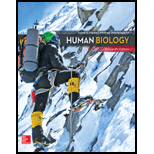
Human Biology
16th Edition
ISBN: 9781260482799
Author: Mader, Sylvia
Publisher: MCGRAW-HILL HIGHER EDUCATION
expand_more
expand_more
format_list_bulleted
Concept explainers
Question
Chapter 24.2, Problem 2CYP
Summary Introduction
To describe:
The trophic level.
Introduction:
Energy is needed by every organism to sustain life. Plants trap the solar energy converting it into carbohydrate which is then eaten and tapped by other organisms like cows, sheep. Lion and other meat-eating organisms, feed on these animals and so on the link or connection continues. Thus, the energy moves in a path which is known as the food chain. However, an ecosystem's availability or preferences may be more complex leading to an interlocking pathway known as a food web.
The food web is used to explain species interaction by categorizing different organisms into specific feeding groups. These feeding groups are referred to as trophic levels.
Expert Solution & Answer
Want to see the full answer?
Check out a sample textbook solution
Students have asked these similar questions
please make the drawing and steps of whats it asking.
thank you!
please fill in empty spots.
thank you!
please fill in the empty sports,
thank you!
Chapter 24 Solutions
Human Biology
Ch. 24.1 - Prob. 1LOCh. 24.1 - Prob. 2LOCh. 24.1 - Prob. 3LOCh. 24.1 - Why can the biosphere be considered a giant...Ch. 24.1 - Prob. 2CYPCh. 24.1 - Prob. 3CYPCh. 24.1 - Prob. 4CYPCh. 24.2 - 1. Recognize the differences between a grazing...Ch. 24.2 - Explain the energy flow among populations through...Ch. 24.2 - Prob. 1BTS
Ch. 24.2 - What is the easiest way to prevent the...Ch. 24.2 - Prob. 3BTSCh. 24.2 - Prob. 4BTSCh. 24.2 - Prob. 1CYPCh. 24.2 - Prob. 2CYPCh. 24.2 - Prob. 3CYPCh. 24.3 - Prob. 1LOCh. 24.3 - Prob. 2LOCh. 24.3 - 3. Identify how human activities can alter each of...Ch. 24.3 - Prob. 1BTBCh. 24.3 - Prob. 2BTBCh. 24.3 - Prob. 1BTSCh. 24.3 - Prob. 2BTSCh. 24.3 - Prob. 1CYPCh. 24.3 - Are the carbon, water, nitrogen, and phosphorus...Ch. 24.3 - Discuss the roles of bacteria in the nitrogen...Ch. 24.3 - Prob. 4CYPCh. 24.3 - Prob. 5CYPCh. 24 - Prob. 1ACh. 24 - Prob. 2ACh. 24 - Prob. 3ACh. 24 - Prob. 4ACh. 24 - Prob. 5ACh. 24 - Prob. 6ACh. 24 - Prob. 7ACh. 24 - Prob. 8ACh. 24 - Prob. 9ACh. 24 - The atmosphere acts as a reservoir. Key: water...Ch. 24 - Prob. 11ACh. 24 - Prob. 12ACh. 24 - Prob. 1TCCh. 24 - Prob. 2TCCh. 24 - Prob. 3TC
Knowledge Booster
Learn more about
Need a deep-dive on the concept behind this application? Look no further. Learn more about this topic, biology and related others by exploring similar questions and additional content below.Similar questions
- In one paragraph show how atoms and they're structure are related to the structure of dna and proteins. Talk about what atoms are. what they're made of, why chemical bonding is important to DNA?arrow_forwardWhat are the structure and properties of atoms and chemical bonds (especially how they relate to DNA and proteins).arrow_forwardThe Sentinel Cell: Nature’s Answer to Cancer?arrow_forward
- Molecular Biology Question You are working to characterize a novel protein in mice. Analysis shows that high levels of the primary transcript that codes for this protein are found in tissue from the brain, muscle, liver, and pancreas. However, an antibody that recognizes the C-terminal portion of the protein indicates that the protein is present in brain, muscle, and liver, but not in the pancreas. What is the most likely explanation for this result?arrow_forwardMolecular Biology Explain/discuss how “slow stop” and “quick/fast stop” mutants wereused to identify different protein involved in DNA replication in E. coli.arrow_forwardMolecular Biology Question A gene that codes for a protein was removed from a eukaryotic cell and inserted into a prokaryotic cell. Although the gene was successfully transcribed and translated, it produced a different protein than it produced in the eukaryotic cell. What is the most likely explanation?arrow_forward
- Molecular Biology LIST three characteristics of origins of replicationarrow_forwardMolecular Biology Question Please help. Thank you For E coli DNA polymerase III, give the structure and function of the b-clamp sub-complex. Describe how the structure of this sub-complex is important for it’s function.arrow_forwardMolecular Biology LIST three characteristics of DNA Polymerasesarrow_forward
- Molecular Biology RNA polymerase core enzyme structure contains what subunits? To form holo enzyme, sigma factor is added to core. What is the name of the structure formed? Give the detailed structure of sigma factor and the function of eachdomain. Please help. Thank youarrow_forwardMolecular Biology You have a single bacterial cell whose DNA is labelled with radioactiveC14. After 5 rounds of cell division, how may cells will contain radioactive DNA? Please help. Thank youarrow_forward1. Explain the structure and properties of atoms and chemical bonds (especially how they relate to DNA and proteins). Also add some pictures.arrow_forward
arrow_back_ios
SEE MORE QUESTIONS
arrow_forward_ios
Recommended textbooks for you
 Biology (MindTap Course List)BiologyISBN:9781337392938Author:Eldra Solomon, Charles Martin, Diana W. Martin, Linda R. BergPublisher:Cengage Learning
Biology (MindTap Course List)BiologyISBN:9781337392938Author:Eldra Solomon, Charles Martin, Diana W. Martin, Linda R. BergPublisher:Cengage Learning Human Biology (MindTap Course List)BiologyISBN:9781305112100Author:Cecie Starr, Beverly McMillanPublisher:Cengage Learning
Human Biology (MindTap Course List)BiologyISBN:9781305112100Author:Cecie Starr, Beverly McMillanPublisher:Cengage Learning
 Concepts of BiologyBiologyISBN:9781938168116Author:Samantha Fowler, Rebecca Roush, James WisePublisher:OpenStax College
Concepts of BiologyBiologyISBN:9781938168116Author:Samantha Fowler, Rebecca Roush, James WisePublisher:OpenStax College Biology Today and Tomorrow without Physiology (Mi...BiologyISBN:9781305117396Author:Cecie Starr, Christine Evers, Lisa StarrPublisher:Cengage Learning
Biology Today and Tomorrow without Physiology (Mi...BiologyISBN:9781305117396Author:Cecie Starr, Christine Evers, Lisa StarrPublisher:Cengage Learning

Biology (MindTap Course List)
Biology
ISBN:9781337392938
Author:Eldra Solomon, Charles Martin, Diana W. Martin, Linda R. Berg
Publisher:Cengage Learning

Human Biology (MindTap Course List)
Biology
ISBN:9781305112100
Author:Cecie Starr, Beverly McMillan
Publisher:Cengage Learning


Concepts of Biology
Biology
ISBN:9781938168116
Author:Samantha Fowler, Rebecca Roush, James Wise
Publisher:OpenStax College


Biology Today and Tomorrow without Physiology (Mi...
Biology
ISBN:9781305117396
Author:Cecie Starr, Christine Evers, Lisa Starr
Publisher:Cengage Learning